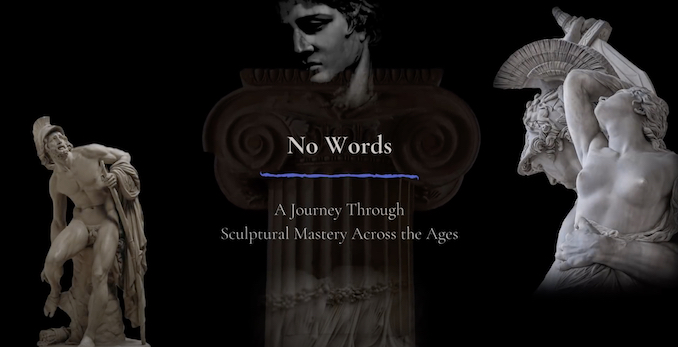”678” is not valid"When I look at the stories in the Bible, I do it, in some sense, with a beginner’s mind. It’s a mystery, this book: how the hell it was made, why it was made, why we preserved it, why it happened to motivate an entire culture for 2,000 years and transform the world. What’s going on? How did that happen? It’s by no means obvious. One of the things that bothers me about casual critics of religion is that they don’t take the phenomena seriously. It’s a serious phenomena, not least because people have the capacity for religious experience, and no one knows why that is."
"[…] The idea is to see if there’s something at the bottom of this amazing civilization that we’ve managed to structure, that I think is in peril, for a variety of reasons. Maybe, if we understand it a little bit better, we won’t be so prone just to throw the damned thing away, which I think would be a big mistake. And to throw it away because of resentment, hatred, bitterness, historical ignorance, jealousy, the desire for destruction, and all of that…I don’t want to go there. It’s a bad idea, to go there. We need to be better-grounded. " ~ Dr. Jordan Peterson
If you’ve ever considered reading the Bible and never found the time or courage to do so, hearing Peterson think through this material, unscripted, is enlightening.
You can find the entire series here.







Jordan Peterson denies Christ. Peterson is a Gnostic who dabbles in occult and is actively engaged in the use of symbolism of Free Masons in his Jungian dualistic nonsense. Why is this being promoted among a group of supposed Christians?
Michael:
Because Peterson draws people in who would never read the Bible to start understanding what is in it and perceiving its power. I don’t agree with many of the things he says, but there are many excellent insights in this series. I have never heard Peterson say he is a Gnostic. Maybe I missed it. I have not heard him or see him dabble in the occult. Maybe I missed it. I don’t see him using the symbolism of Free Masons any more than I do.
Christianity is a very big tent defined first and foremost by love and intelligence. Peterson is welcome here – including because he recognizes the power of the Bible more than most people do even though I don’t believe he understands it at the deepest level. And – most important – because he tries harder to be a good Christian than many Christians I know.
That includes the endless stream of pastors busy promoting the mark of the beast to help improve their cash flows.
Hope that helps,
Catherine
Why would you limit the degree to which you understand something to ‘what that person says’ – have you ever read Peterson’s work? My guess is no. So, you’re also unaware he was responsible for writing marxist policy papers for the UN. Because of your excessively liberal interpretation of Christianity you will also be unaware that Peterson’s writings are riddled with anti-christian rhetoric including Gnostic dualism, and his advocation for the use of auto-pen (that is the use of invoking spirits through ritual in order to concoct his works), and openly speaks in letters to his father about his ‘pen of Light’ (read: Lucifer). In addition, its rather public that we are not dealing with a man who is mentally stable, who became addicted to prescription drugs, and required evac to Russia for treatment. The worlds great psychology professor, telling generations of young men to clean their rooms, and yet his own life is one verifiable struggle with mental illness. Sorry, if you cannot see the contradictions here, you’re blind. Peterson denies Christ as a historical figure. Not Christian. No, Jesus is not a version of the Egyptian god Osiris, also a Peterson claim, also decidedly NOT Christian.
Since you seem to be a video afficianado, educate yourself on Peterson:
https://www.youtube.com/watch?v=O7u3Lu-kzgg
https://youtu.be/LVj5BdRv9Js
An excellent article spelling out Peterson’s obviously Gnostic (and therefore anti-Christian) worldview: https://dailycaller.com/2018/06/03/jordan-peterson-anti-christian-vision/
Best,
mc
Here is Petersons piece on UN Sustainability (read: Agenda 2030, Great Reset, and no doubt funded by our favorite Mr. Global: https://en.unesco.org/system/files/GSP_Report_web_final.pdf
A great synopsis of Peterson’s Globalist leaning and ties:
https://youtu.be/WXYuqrO8LLo
This is no different than Jack Kruse, Catherine. These are wolves in sheeps clothing.
Thanks, Micheal. Will take a look. I have one strong disagreement with Peterson that I know of, so could be more.
OK, took a look. In the first document, Peterson’s name is at the very bottom of a 2012 document being thanked for advising one person who was involved. This is like thousands of other processes lead by groups like the UN. Thousands of academics get invited in for meaningless or bit roles, money gets thrown around and credentials as well Busy people get tagged with little understanding of what they are part of. Use to happen to me before I left the establishment. What this tells me about Peterson or his values is exactly nothing other than he is naive about the game – which has been clear more or less all along.
I tried to watch the second link – the video – gave up after 5 minutes. I often do when I am watching something that feels like it has entrainment overlaid on it. It was a hit piece and not one that looked like it was interested in a serious discussion of the ideas and debate involved.
Yes, Peterson’s meteoric rise is suspicious – but a person being used is different that a person trying to do harm. Looks to me after the rise got going TPTB worked hard to try to destroy Peterson. Would not surprise me if poisoning or EMF targeting was involved.
There is a lot to be learned from Peterson – but that does not include a superior understanding of how the system works top down on the covert side. That applies to most of 8 billion people in my experience.
I see him as a much more personally moral man than Kruse.
Catherine
Hello Catherine;
Here is my research summary.
Best Practice in FairyTales
Fairy Tales/myth, speak of things that never were revealing truths that always are… Show me your fairy tales and I’ll show you your culture.
Jean Houston. PhD
Ballads, limericks and oral tradition preserve our collective wisdom. Linguists trace the roots of fairytale themes to areas in the middle east. The stories are meant to help us see human nature and the world more clearly. The information requires updating, revising and retelling . The oldest tale concerns the “pot that never runs dry”. Like all enduring themes this one has been revised to ensure its relevance through the ages. For example, the pot evolved from cauldron to Grail.
“We can interpret fairy tales as answers to the ultimate questions about our outer and inner needs.” -Rudolf Steiner
Violence is a hallmark of classical tales, Murder, mutilation, cannibalism, infanticide, incest as well as all manner of deception and chos abound. The Brothers Grimm Cinderella is a good illustration, contrary to Disney’s interpretation, this story about child abuse and parental neglect.
Cinderella is the only child of a prosperous widower. Her childhood is full of heartache and loneliness.compounded by her stepmother’s cruelty, her stepsisters’ hostility and her father’s indifference. Her only consolation comes from the birds and a hazel tree that she waters with her tears.
When Prince Charming comes to find the mysterious owner of the slipper he deals with
Cinderella’s father. The father makes no attempt to advocate for his own child but allows the step mother’s ambition to dominate.
The wicked stepmother mutilates her daughter’s feet to fit the slipper. The prince is completely taken in by the scam not once but twice. In both instances the prince is returning to the castle with his false bride when he is alerted to the deception by a dove nesting in a hazel tree. “Back again! back again! look at the shoe! The shoe is too small, and not made for you! Prince! prince! look again for thy bride, For she’s not the true one that sits by thy side.”
The prince confronts the father.’ This is not the true bride. Don’t you have any other daughters?’
At this point Cinderella steps forward to claim her shoe. It fits perfectly but the prince has to draw near and look into her face. ‘This is the right bride.” Then he took Cinderella on his horse and rode away. And when they came to the hazel-tree the white dove sang— “Prince! prince! take home thy bride, For she is the true one that sits by thy side!”
CS Lewis cautions against minimizing the terrors of these tales. He reasons that doing so banishes all that ennobles the heroine’s suffering or makes it endurable. The best Fairy tales present witches and monsters side by side with comforters and protectors. Radiant champions surmount their pain. They use their wits, magical allies and their attunement with nature to right wrongs and restore order.
Storytellers /readers are cautioned against dramatizing the narrative. Approaching the material with restraint allows the listener’s creative imagination to more fully engage.
Here is a Russian fairytale for your consideration. An old man and an old woman have two daughters; one was fairly unattractive, but the younger, Nastya, was skilled and beautiful. The mother did not love them equally. She wanted her favourite daughter, the less attractive one, to marry. However all the potential husbands instantly preferred Nastya.
The old woman decides to send Nastya away. She tells her husband to take her to the forest in the middle of winter and leave her there to die. The inhabitants of the forest, including Father Frost, decide to help Nastya because of her kind heart,
Fairy tales are found in every culture throughout the world. R. J. Stewart, author of 40 titles on Celtic mythology, Faery Tradition, maintains Fairy lore is the source of all religions.
This Japanese folktale is an example.
One night, the Man on the Moon came down to earth disguised as a beggar. He chanced upon a Fox, a Monkey, and a Rabbit (usagi) and asked for some food. The Fox brought him fish from a stream, and the Monkey brought fruit from the trees, but the Rabbit could only offer grass. So he told the beggar to build a fire, and when it was built, threw himself onto the flames to offer himself to the Man.
Amazed by the Rabbit’s generosity, the beggar transformed back into the Man on the Moon and pulled the Rabbit from the fire. To honor the Rabbit’s kindness, the Man on the Moon carried the Rabbit back to the moon to live with him. Now, if you look at the full moon, you can see the outline of the Rabbit pounding mochi on the moon.
Fairy tales aid the moral development of a community. C. S. Lewis says they “combine the richest spiritual wisdom with the simplest manner of expression,” Good fairy tales provide profound moral lessons in a form that delights and inspires. The best of these stories addresses both head and heart by providing instruction in right and wrong while exciting the imagination.
The human soul has an inextinguishable need to have the substance of fairy tales flow through its veins, just as the body needs to have nourishing substances circulate through it.” -Rudolf Steiner
Key elements of a fairy tale:
Noble heroes /heroines worthy of emulation.
Talking animals optional
Fairies (optional)
Vegetable and mineral kingdoms influence the plot
Simple story told in simple language
Magic is an essential element to the story
Hero/heroine should be beautiful and cunning
Conclude with a happy ending.
Primary themes:
Courage
Love/Friendship
Forgiveness/Redemption
Survival